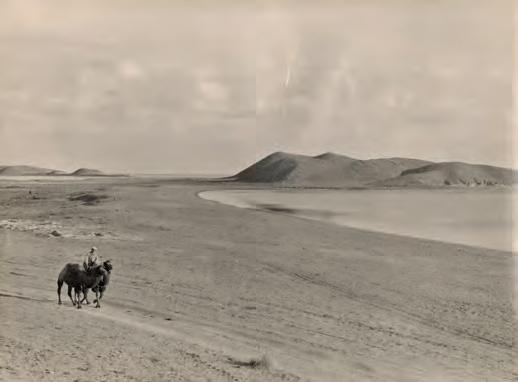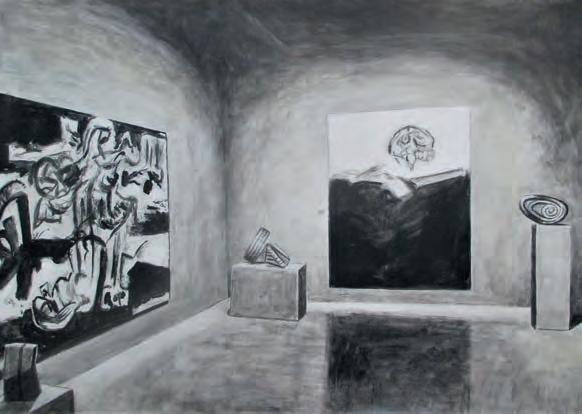
8 minute read
Vladislav Shapovalov
Vladislav Shapovalov
Folder 93 [Archivo 93] , 2014
Advertisement
La obra Folder 93 pertenece a un proyecto mayor, Image diplomacy, desarrollado por Vladislav Shapovalov en torno a los archivos de exposiciones fotográficas y fílmicas prefabricadas, producidas por la Unión Soviética para ser mostradas en el bloque capitalista durante la Guerra Fría. En la década de los 50 la propaganda política explícita que había caracterizado los años de la Guerra Mundial tendió a diluirse en una batalla ideológica de largo alcance. Esta nueva estrategia resignificaba imágenes y objetos en torno a las economías del bienestar y el consumo y contribuía a consolidar la nueva esfera tecnológica y mediática. Un ejemplo de este tipo de proceder fue la conocida exposición The Family of Man, inaugurada en el MoMA en 1955. Ésta itineró hasta 1962 a 37 países, incluida la URSS del Krushchev postestalinista, y tuvo nueve millones de visitantes. Las exposiciones basadas en fotografías tenían un indudable atractivo popular y fueron ampliamente utilizadas por la diplomacia cultural de la nueva época. La facilidad de su transporte y su reproductibilidad permitía organizar muestras que podían enviarse en maletas y disponerse con facilidad en las estructuras modulares.
La Unión Soviética desplegó una amplia campaña de este tipo de exposiciones que
Folder 93 is part of Image Diplomacy, a larger project by Vladislav Shapovalov that explores archives of prefabricated photography exhibitions and films produced by the Soviet Union to be shown in capitalist countries during the Cold War. In the 1950s, the blatant political propaganda that had characterized the war years gradually became less belligerent and turned into a long-term ideological battle. The new strategy resignified images and objects to revolve around the welfare and consumer economies and helped to consolidate the new media and technology sphere. A case in point was the famous exhibition The Family of Man, which opened at the MoMA in 1955. The show travelled to thirty seven countries, including Khrushchev’s post-Stalinist USSR, and was seen by nine million people. Photography exhibitions had undeniable mass appeal and were widely used by cultural diplomacy in the new era. The fact that they were easy to transport and reproduce meant that photos could be sent to a venue in suitcases and easily displayed in modular structures.
The Soviet Union launched an ambitious campaign of photography exhibitions to showcase the success of its policies. Many of them were
enseñaban los logros de sus políticas. Muchas de ellas se desarrollaron mediante las relaciones que los soviéticos tenían con los representantes de las sociedades de amigos de la URSS, los VOKS y los SSOD, que estaban presentes en 47 países. El proyecto de Shapovalov se centra en la reconstrucción de una de estas exposiciones, Paisajes de la Unión Soviética, que el artista encontró en el archivo de la Associazione italiana per i rapporti culturali con l’Unione Sovietica de Milán. Aunque en estas muestras eran frecuentes las imágenes ilustrando la industrialización del país, en este caso, las fotografías mostraban una naturaleza vacía, despoblada y sin apenas signos de intervención humana. Bajo una cierta estética paisajística, estos grandes espacios deshabitados enfatizan la diversidad y potencialidad de los recursos naturales de la URSS.
arranged through Soviet relations with representatives of societies of friends of the USSR, the VOKS and the SSOD, present in forty seven countries. Shapovalov’s project focuses on reconstructing one of those exhibitions, Landscapes of the Soviet Union, which the artist discovered in the archives of the Associazione Italiana per i Rapporti Culturali con l’Unione Sovietica in Milan. Although such shows often featured images of the country’s industrialization, in this case the photographs reveal barren, empty natural settings with hardly any signs of human intervention. With an aesthetic close to landscape art, these vast, uninhabited spaces underscore the diversity and potential of the USSR’s natural resources.




Porter McCray Museum of American Art
New Spanish Painting and Sculpture –Part I and II [Nueva pintura y escultura españolas –Partes I y II ], 2017
El Museum of American Art es un proyecto que reflexiona sobre los modos en los que la consolidación del canon del arte moderno se ligó, en la segunda mitad del s. XX, a la influencia del Museum of Modern Art de Nueva York. Para hacer visible la construcción político-cultural de este canon, el MoAA actúa mediante la reconstrucción de algunas de las exposiciones que más contribuyeron a su formación. Una línea de actuación fundamental fue el International Program of Circulating Exhibitions, decisivo a la hora de hacer visible el expresionismo abstracto en buena parte del mundo y con el que dos de sus exposiciones llegaron a España: Modern Art in the USA (Barcelona, 1953) y The New American Painting (Madrid, 1958). Estas itinerancias fueron facilitadas por el Convenio hispano-norteamericano, firmado en 1953, en el nuevo marco geopolítico derivado de la Guerra Fría. Tras una década de aislacionismo, el Convenio permitía que el gobierno estadounidense accediera al uso de las bases militares españolas y que España recibiera ayuda económica y apoyo para su aceptación internacional. Este reconocimiento se consolidó en 1955, cuando España se incorpora al Consejo de Seguridad de la O.N.U.
Este cambio de estatus fue aprovechado por el régimen franquista para desplegar
The Museum of American Art is a project that reflects on the role of the Museum of Modern Art in New York in establishing the canons of modern art in the second half of the 20th century. In order to visually trace the politico-cultural construction of these canons, the MoAA recreates some of the most important exhibitions that shaped them. A fundamental part of this process was the International Program of Circulating Exhibitions, an initiative that was instrumental in promoting American Abstract Expressionism across the world and brought two major shows to Spain: Modern Art in the USA (Barcelona, 1953) and The New American Painting (Madrid, 1958). These traveling exhibitions were made possible by the Pact of Madrid signed in 1953, in the new geopolitical scenario spawned by the Cold War. After a decade of virtual isolation for Spain, the pact gave the US government access to Spanish military bases while Spain received financial aid and support in its campaign for international acceptance. That recognition came in 1955 when Spain joined the UN Security Council.
Franco’s regime seized the opportunity afforded by this change of status to roll out a brand-new cultural policy with diplomatic and propagandistic aims; as a result, Spain began to participate
una renovada política cultural con fines diplomático-propagandísticos, que se concretó en una creciente participación en bienales internacionales, como las de São Paulo o Venecia, y en la organización de exposiciones en el exterior. De este modo, el intercambio bilateral se completó con tres exposiciones de artistas españoles en Nueva York en la primavera-verano de 1960, entre las que destaca New Spanish Painting and Sculpture en el MoMA que itineró a varias ciudades, incluyendo Washington D.C. En estos viajes de ida y vuelta, bajo la retórica del universalismo artístico y la apoliticidad expresiva del arte abstracto, gobiernos tan aparentemente contrapuestos como la democracia estadounidense y la dictadura franquista encontraron un espacio de instrumentalización en común. La presentación de los informalistas españoles en Nueva York pretendía establecer un juego de pares con los expresionistas abstractos, mientras el régimen lavaba la imagen de la dictadura. Los expresionistas, por su lado, contribuyeron a superar la fractura entre Estados Unidos y el arte moderno europeo, hasta entonces polémico y con problemas de adaptación en su imaginario artístico. Con el paso del tiempo, la evolución de las prácticas artísticas ha dejado obsoleto este canon eurocéntrico, pero la reconstrucción contemporánea de sus escenarios, alentada por una intención crítica, no nostálgica, permite entender mejor sus modos de operar. Por ello, esta recuperación no trata de devolver el carácter de fetiche a las obras, sino que tanto los originales como las copias se desmitifican al exponerse como documentos de época o como souvenirs de otro tiempo.
more actively in international events like the São Paulo and Venice biennials and organized exhibitions of Spanish art abroad. Thus, the bilateral exchange was rounded out with three New York shows dedicated to Spanish artists in the spring/summer of 1960, most notably the MoMA exhibition New Spanish Painting and Sculpture which later toured to Washington, DC, and other cities. On this two-way journey, the rhetoric of artistic universality and the expressive apolitical nature of abstract art allowed two seemingly antithetical governments—American democracy and the Franco dictatorship—to find a mutually advantageous common ground. By presenting the brightest stars of Spanish Art Informel in New York, the regime hoped to place them on equal footing with the Abstract Expressionists while also whitewashing the dictator’s image abroad. For their part, the Expressionists helped to bridge the divide between the United States and modern European art, hitherto plagued by controversy and difficulties in adapting its artistic imagery. Over the years, the evolution of artistic practices has rendered this Eurocentric canon obsolete, but a contemporary recreation—motivated by critical, not nostalgic, intentions—of the settings in which it thrived gives us better insight into how it worked. Consequently, this return to the past does not attempt to reinstate artworks as fetishes, but to divest both originals and copies of their mystical aura by exhibiting them as period documents or souvenirs of another time.












